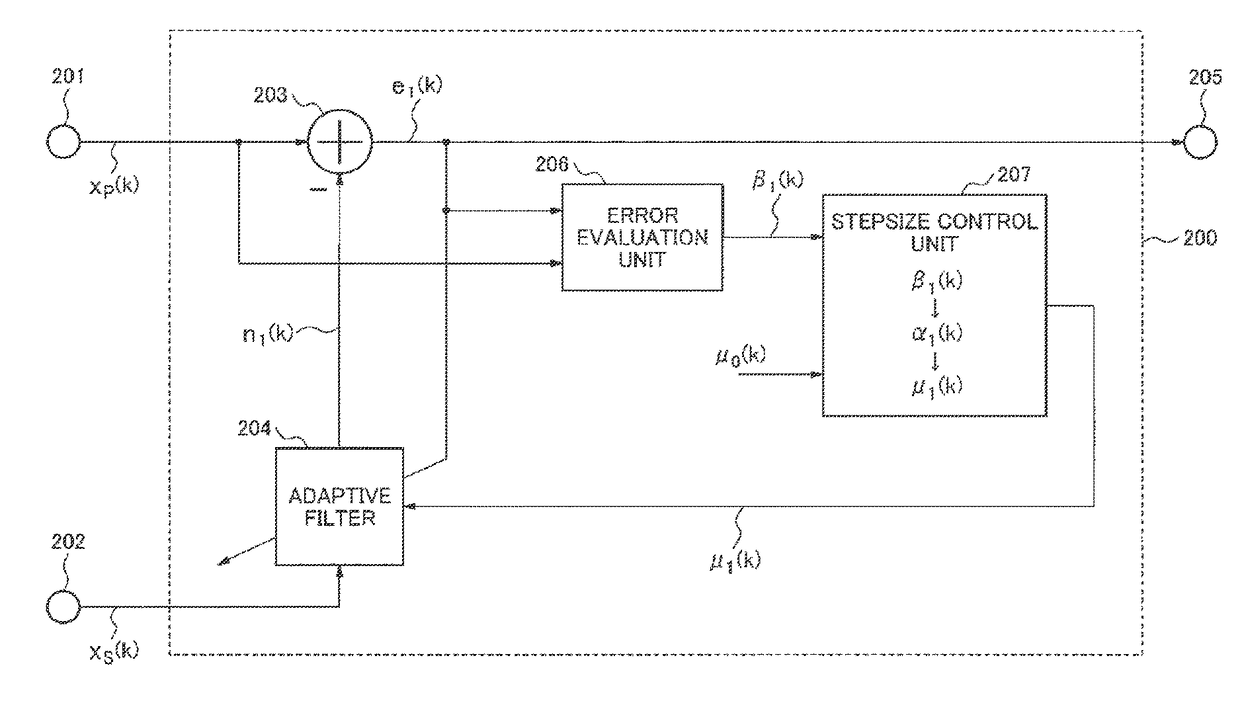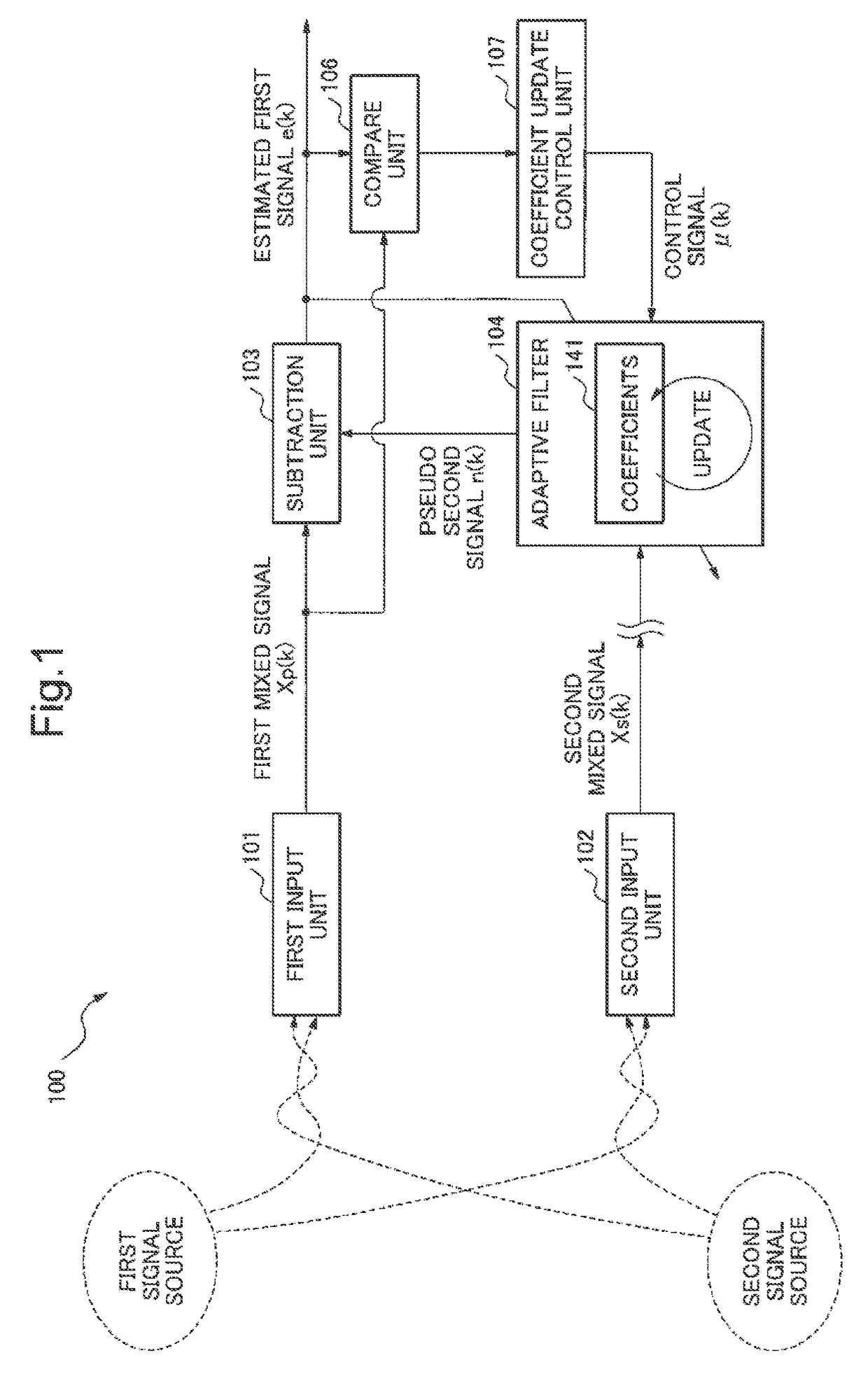Signal processing device, signal processing method and signal processing program for noise cancellation
a signal processing and signal processing technology, applied in the field of signal processing, can solve the problems of being a big problem and its estimation accuracy of noise inferior to the second adaptive filter, and achieve the effects of low processing cost, low residue of the second signal, and no delay
- Summary
- Abstract
- Description
- Claims
- Application Information
AI Technical Summary
Benefits of technology
Problems solved by technology
Method used
Image
Examples
first exemplary embodiment
[0027]A signal processing device 100 as a first exemplary embodiment of the present invention will be described using FIG. 1. The signal processing device 100 of FIG. 1 is a device which obtains, from a first mixed signal xp(k) in which a first signal and a second signal are mixed, an estimated first signal e(k) as an estimated value of the first signal.
[0028]As shown in FIG. 1, the signal processing device 100 includes a first input unit 101, a second input unit 102, a subtraction unit 103, an adaptive filter 104, a compare unit 106 and a coefficient-update control unit 107.
[0029]The first input unit 101 inputs the first mixed signal xp(k) in which the first signal and the second signal are mixed. The second input unit 102 inputs a second mixed signal xs(k) in which the first signal and the second signal are mixed in a different proportion from the first mixed signal xp(k).
[0030]The subtraction unit 103 subtracts a pseudo second signal n(k) which is estimated to be mixed in the fir...
second exemplary embodiment
[0033]As a signal processing device according to a second exemplary embodiment of the present invention, a noise cancellation device which cancels a part or all of the noise from a deteriorated signal (a signal in which a desired-signal and noise are mixed), and outputs an emphasized signal (a signal in which the desired-signal is emphasized) is described. Here, the deteriorated signal corresponds to the first mixed signal in which the first signal and the second signal are mixed, and the emphasized signal corresponds to a desired voice signal (estimated first signal).
(Explanation of a Basic Technology of Noise Cancellation)
[0034]Hereinafter, a basic technology of noise cancellation for cancelling a noise, an interference signal, and an echo or the like, which are mixed with the desired-signal inputted from a microphone, a hand set, and a channel or the like by the adaptive filter, or emphasizing the desired-signal will be described briefly.
[0035]As disclosed in patent literatures 1...
third exemplary embodiment
[0062]A third exemplary embodiment of the present invention will be described using FIG. 3. The error evaluation unit 206 according to the second exemplary embodiment compares the primary signal xp(k) and the estimated desired-signal e1(k) without any additional operation on them and evaluates the error. In contrast, an error evaluation unit 306 of this exemplary embodiment averages either one or both of the primary signal xp(k) and the estimated desired-signal e1(k) and uses them for evaluation of the error. The error evaluation unit 306 can absorb statistical uncertainty of the signal and obtain more correct evaluation result β1(k) by using the average values. The average values can be calculated using the average based on an FIR filter (a moving average using a sliding window), the average based on an IIR filter (leaky integration) and so on. When the average value of the estimated desired-signal e12(k) is represented by e12(k) bar, then e12(k) bar can be described as the next (E...
PUM
 Login to View More
Login to View More Abstract
Description
Claims
Application Information
 Login to View More
Login to View More - R&D
- Intellectual Property
- Life Sciences
- Materials
- Tech Scout
- Unparalleled Data Quality
- Higher Quality Content
- 60% Fewer Hallucinations
Browse by: Latest US Patents, China's latest patents, Technical Efficacy Thesaurus, Application Domain, Technology Topic, Popular Technical Reports.
© 2025 PatSnap. All rights reserved.Legal|Privacy policy|Modern Slavery Act Transparency Statement|Sitemap|About US| Contact US: help@patsnap.com



